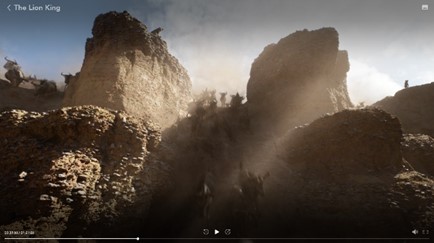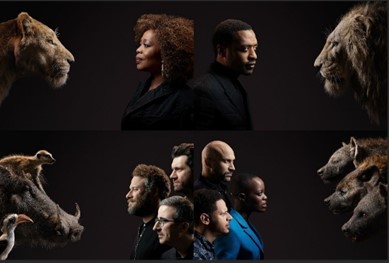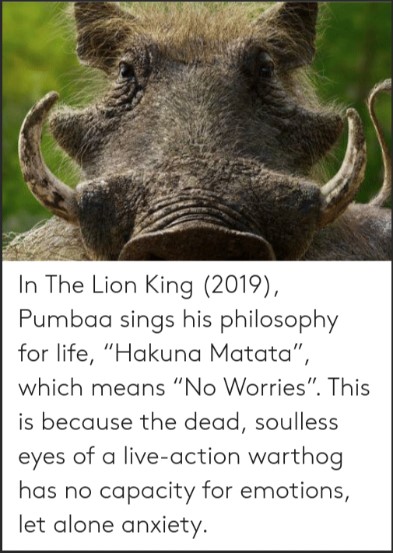‘There’s a stampede, in the pride lands’, Zazu’s memorable line is word-for-word identical to the 1994 animation. But where the animation focused on a simple plot, Jon Favreau’s recreation with CGI animals creates depth by building more of the animals’ characterisation into the story, I will question how this creates problems with humanising certain animals over others in this scene. This scene comes as Scar is attempting to take out Simba and Mufasa, using the Hyenas to cause a stampede of wildebeest in an inescapable valley, where Simba is trapped.

Figure 1 The Lion King. Rob Minkoff, Roger Allers. Walt Disney Feature Animation. 1994. Animated Wildebeest stampede. 
Figure 2 Taken from the 2019 recreation, comparative to figure 1.

Figure 3 Final promotion for The Lion King, where the voice actors appear to face their CGI animal counterparts.
This version of the Lion King cleverly presents animal-animal relations within the story. As you can see in figure 2, this striking image uses dynamic proxemics to reflect the hierarchy of the species within the frame: the Hyenas standing at the top of the columns as threatening predator, whilst the Wildebeest run down the gorge as scared prey. The camera angle which narrowly focuses on looking up at the wall of Wildebeest makes the scene intimidating, as you are placed in Simba’s position whilst feeling the sinister presence of the Hyenas watching the terror. As a result, it makes the hierarchy of animals in The Lion King all the more defined as the Hyenas appear to assert some superiority, appearing to stand like guards on top of turrets. This hierarchy is important in reflecting the issue of which animals are ‘humanised emotionally’ through their position in the food chain, Favreau uses something that is distinctly an animal-animal relation to choose who becomes more intelligent. For example, in a predator-prey scenario you would imagine the predator would be the most intelligent, but does that make sense within the world of the film since other species which are less threatening take on human traits also, so why do the Wildebeest dismiss Simba? Admittedly their behaviour is typical of them when threatened (see figure 4) in this world they had the potential to acknowledge Simba, especially given his royalty which they would have clearly been aware of given how the film starts with all the animals at his arrival.
d Wildebeest Favreau chose to use a new type of augmented reality technology for the film. However, by making them look ‘real’ he risked breaking the barrier between animal documentary and family film, particularly in this scene. This is problematic since it cannot be used for educational purposes as well as entertainment since the films realistic depiction may give children an inappropriate presentation of how these animals behave in the wild. Therefore, when making sense of the film we have to consider it as a family film that uses the human characteristics given to the Hyena’s of being sly, clever, and sadistic as important to the narrative plot, regardless of the stereotype surrounding the species, in order to evade the problem created by letting the have intelligence and a voice and not the Wildebeest.

Figure 5 taken from a Facebook post around the release of the movie as people reacted to the seaming lack of emotion shown in the CGI.
Ultimately, the image of figure 2 and the ensuing action presents the conflict between the human-animal relations through the choice as to how and who is more humanised for the purpose of the narrative.